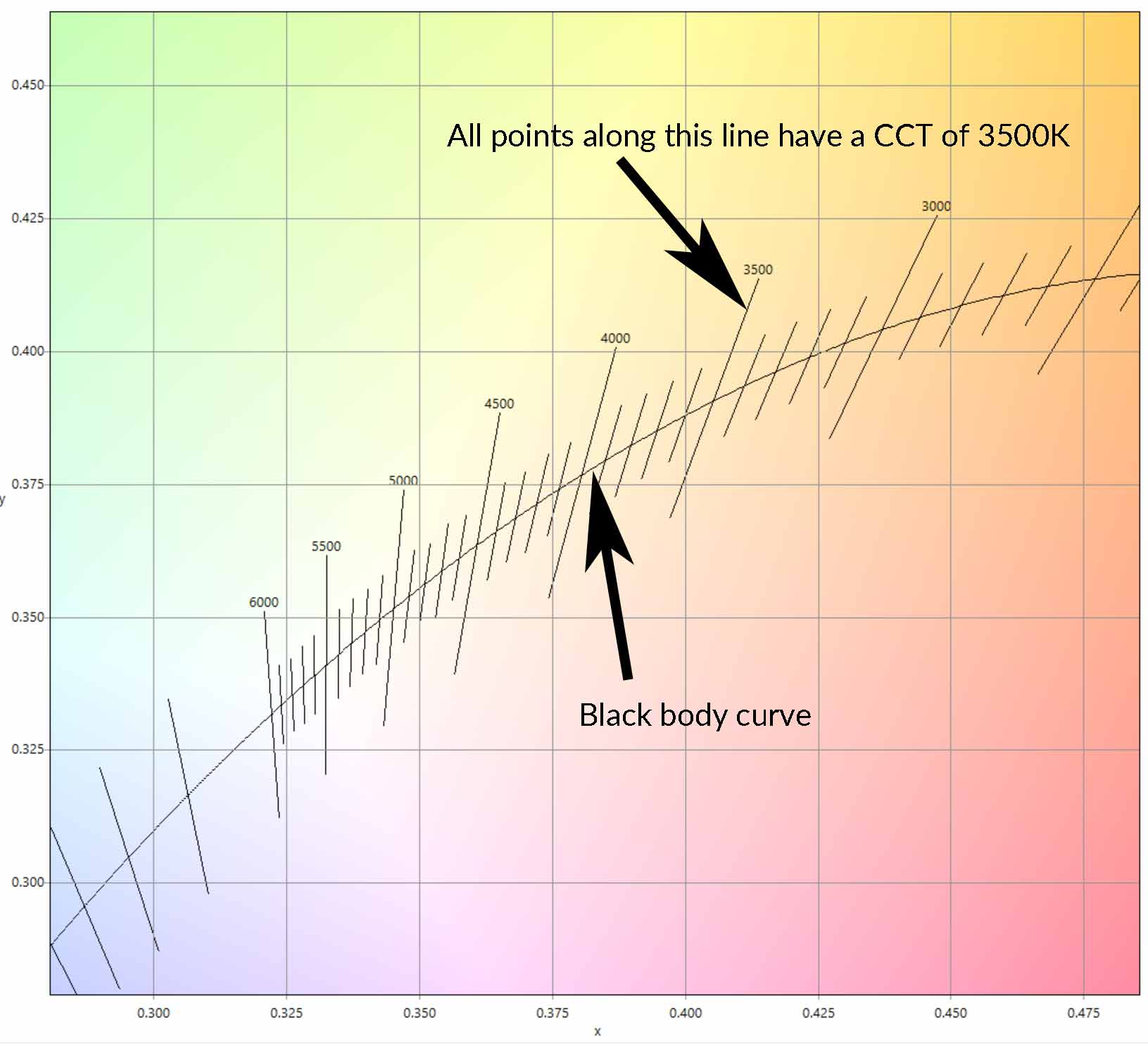
Calculate Duv from CIE 1931 xy coordinates
The Duv of a color point in a chromaticity coordinate system can be used to describe its distance from the black body curve. Duv can be approximated using just a pair of xy coordinates from CIE 1931. Use the formula below, or simply plug in the x and y values into our online calculator.
See here to calculate the correlated color temperature (CCT) value from CIE 1931 xy coordinates.
CIE x:
CIE y:
Duv is a metric that is short for "Delta u,v" (not to be confused with Delta u',v') and describes the distance of a light color point from the black body curve.
It is typically used in conjunction with a correlated color temperature (CCT) value in explaining how close to the black body curve ("pure white") a particular light source is.
A negative value indicates that the color point is below the black body curve (magenta or pink) and a positive value indicates a point above the black body curve (green or yellow).
A more positive value indicates a point farther above the black body curve, while a more negative value indicates a point farther below the black body curve.
In short, Duv conveniently provides both magnitude and directional information about a color point's distance from the black body curve.
Duv is an important metric whenever discussing color sensitive lighting applications, such as film & photography. This is because CCT alone does provide enough information about the exact color.
In the graphic below, you will find iso-CCT lines for various CCT values. Iso-CCT lines describe points whose CCT value are the same.
For 3500K, you will see the line extend from a yellowish hue in the area above the black body curve (larger Duv value), while it will transition towards a pink/magenta hue as you move down the same 3500K iso-CCT line below the black body curve (lower, negative Duv value).
In other words, if a lamp has a CCT value of 3500K, in reality, it can be anywhere along this iso-CCT line.

On the other hand, if we were given information that a lamp had a CCT value of 3500K and a Duv = 0.001, this would give us sufficient information to know that it is along the 3500K iso-CCT line, slightly above the black body curve.
If and only if both Duv and CCT values are provided, an exact color point can be pinpointed.
ANSI and EnergyStar recommend Duv values between -0.006 and +0.006. For more demanding applications, a Duv range between -0.003 and +0.003 is preferred. (Waveform Lighting's FilmGrade series of products have a Duv tolerance of +/- 0.003).
The formula below converts CIE 1931 xy values into its Duv value.
u = (4*x) / (-2*x + 12*y + 3);
v = (6*y) / (-2*x + 12*y + 3);
k6 =-0.00616793;
k5 =0.0893944;
k4 =-0.5179722;
k3 =1.5317403;
k2 =-2.4243787;
k1 =1.925865;
k0 =-0.471106;
Lfp = Math.sqrt(Math.pow((u - 0.292),2)+Math.pow((v-0.24),2));
a = Math.acos((u-0.292)/Lfp);
Lbb = k6*Math.pow(a,6) + k5*Math.pow(a,5) + k4*Math.pow(a,4) + k3*Math.pow(a,3) + k2*Math.pow(a,2) + k1*a+k0;
Duv = Lfp - Lbb;
See here to calculate the correlated color temperature (CCT) value from CIE 1931 xy coordinates.
CIE 1931 xy to Duv
CIE y:
Result: -
What is Duv?
Duv is a metric that is short for "Delta u,v" (not to be confused with Delta u',v') and describes the distance of a light color point from the black body curve.
It is typically used in conjunction with a correlated color temperature (CCT) value in explaining how close to the black body curve ("pure white") a particular light source is.
A negative value indicates that the color point is below the black body curve (magenta or pink) and a positive value indicates a point above the black body curve (green or yellow).
A more positive value indicates a point farther above the black body curve, while a more negative value indicates a point farther below the black body curve.
In short, Duv conveniently provides both magnitude and directional information about a color point's distance from the black body curve.
Why is Duv important?
Duv is an important metric whenever discussing color sensitive lighting applications, such as film & photography. This is because CCT alone does provide enough information about the exact color.
In the graphic below, you will find iso-CCT lines for various CCT values. Iso-CCT lines describe points whose CCT value are the same.
For 3500K, you will see the line extend from a yellowish hue in the area above the black body curve (larger Duv value), while it will transition towards a pink/magenta hue as you move down the same 3500K iso-CCT line below the black body curve (lower, negative Duv value).
In other words, if a lamp has a CCT value of 3500K, in reality, it can be anywhere along this iso-CCT line.

On the other hand, if we were given information that a lamp had a CCT value of 3500K and a Duv = 0.001, this would give us sufficient information to know that it is along the 3500K iso-CCT line, slightly above the black body curve.
If and only if both Duv and CCT values are provided, an exact color point can be pinpointed.
What are acceptable Duv values?
ANSI and EnergyStar recommend Duv values between -0.006 and +0.006. For more demanding applications, a Duv range between -0.003 and +0.003 is preferred. (Waveform Lighting's FilmGrade series of products have a Duv tolerance of +/- 0.003).
CIE 1931 xy to Duv
The formula below converts CIE 1931 xy values into its Duv value.
u = (4*x) / (-2*x + 12*y + 3);
v = (6*y) / (-2*x + 12*y + 3);
k6 =-0.00616793;
k5 =0.0893944;
k4 =-0.5179722;
k3 =1.5317403;
k2 =-2.4243787;
k1 =1.925865;
k0 =-0.471106;
Lfp = Math.sqrt(Math.pow((u - 0.292),2)+Math.pow((v-0.24),2));
a = Math.acos((u-0.292)/Lfp);
Lbb = k6*Math.pow(a,6) + k5*Math.pow(a,5) + k4*Math.pow(a,4) + k3*Math.pow(a,3) + k2*Math.pow(a,2) + k1*a+k0;
Duv = Lfp - Lbb;
Other Posts
Browse Waveform Lighting Products
A-Series LED Bulbs
Our A19 and A21 lamps fit in standard lamp fixtures and are perfect for floor and desk lamp fixtures.
Candelabra LED Bulbs
Our candelabra LED bulbs offer soft and warm light output in a decorative bulb style that fits E12 lamp fixtures.
BR30 LED Lamps
BR30 lamps are ceiling lamps that fit in residential and commercial fixtures with 4-inch or wider openings.
